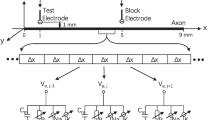Abstract
High frequency alternating current (HFAC) sinusoidal waveforms can block conduction in mammalian peripheral nerves. A mammalian axon model was used to simulate the response of nerves to HFAC conduction block. Sinusoidal waveforms from 1 to 40 kHz were delivered to eight simulated axon diameters ranging from 7.3 to 16 μm. Conduction block was obtained between 3 to 40 kHz. The minimum peak to peak current at which block was obtained, defined as the block threshold, increased with increasing frequency. Block threshold varied inversely with axon diameter. Upon initiation, the HFAC waveform produced one or more action potentials. These simulation results closely parallel previous experimental results of high frequency motor block of the rat sciatic and cat pudendal nerve. During HFAC block, the axons showed a dynamic steady state depolarization of multiple nodes, strongly suggesting a depolarization mechanism for HFAC conduction block.









Similar content being viewed by others
References
Bhadra N, Kilgore KL (2004) Direct current electrical conduction block of peripheral nerve. IEEE Trans. Neural. Syst. Rehabil. Eng. 12: 313–324.
Bhadra N, Kilgore KL (2005) High-frequency electrical conduction block of mammalian peripheral motor nerve. Muscle Nerve 32: 782–790.
Bhadra N, Bhadra N, Kilgore K, Gustafson KJ (2006) High frequency electrical conduction block of the pudendal nerve. J. Neural. Eng. 3: 180–187.
Bowman BR, McNeal DR (1986) Response of single alpha motoneurons to high-frequency pulse trains. Firing behavior and conduction block phenomenon. Appl. Neurophysiol. 49: 121–138.
Forbes A, Rice LH (1929) Quantitative studies of the nerve impulse IV. Fatigue of the peripheral nerve. Am. J. Physiol. 90: 119– 145.
Grill WM, Mortimer JT (1997) Inversion of the current-distance relationship by transient depolarization. IEEE Trans. Biomed. Eng. 44: 1–9.
Hines ML, Carnevale NT (1997) The NEURON simulation environment. Neural. Comput. 9: 1179–1209.
Hodgkin AL, Huxley AF (1952) A quantitative description of membrane current and its application to conduction and excitation in nerve. J. Physiol. 117: 500–544.
Kilgore KL, Bhadra N (2004) Nerve conduction block utilising high-frequency alternating current. Med. Biol. Eng. Comput. 42: 394–406.
Krauthamer V, Crosheck T (2002) Effects of high-rate electrical stimulation upon firing in modelled and real neurons. Med. Biol. Eng. Comput. 40: 360–366.
McCreery DB, Agnew WF, Yuen TG, Bullara L (1990) Charge density and charge per phase as cofactors in neural injury induced by electrical stimulation. IEEE Trans. Biomed. Eng. 37: 996– 1001.
McIntyre CC, Richardson AG, Grill WM (2002) Modeling the excitability of mammalian nerve fibers: influence of afterpotentials on the recovery cycle. J. Neurophysiol. 87: 995–1006.
Mortimer JT (1981) Motor prostheses. American Physiology Society, Bethesda, MD.
Ranck JB Jr (1975) Which elements are excited in electrical stimulation of mammalian central nervous system: a review. Brain Res. 98: 417–440.
Rattay F (1990) Electrical Nerve Stimulation. Springer-Verlag, Vienna, Austria.
Rattay F (1990) Electrical Nerve Stimulation; Theory, experiments and applications. Springer-Verlag, New York.
Richardson AG, McIntyre CC, Grill WM (2000) Modelling the effects of electric fields on nerve fibres: influence of the myelin sheath. Med. Biol. Eng. Comput. 38: 438–446.
Sassen M, Zimmermann M (1973) Differential blocking of myelinated nerve fibres by transient depolarization. Pflugers. Arch. 341: 179–195.
Sawan M, Hassouna MM, Li JS, Duval F, Elhilali MM (1996) Stimulator design and subsequent stimulation parameter optimization for controlling micturition and reducing urethral resistance. IEEE Trans. Rehabil. Eng. 4: 39–46.
Schwarz JR, Reid G, Bostock H (1995) Action potentials and membrane currents in the human node of Ranvier. Pflugers. Arch. 430(2): 283–292.
Solomonow M, Eldred E, Lyman J, Foster J (1983) Control of muscle contractile force through indirect high-frequency stimulation. Am. J. Phys. Med. 62: 71–82.
Tai C, Roppolo JR, de Groat WC (2005a) Response of external urethral sphincter to high frequency biphasic electrical stimulation of pudendal nerve. J. Urol. 174(2): 782–786.
Tai C, de Groat WC, Roppolo JR (2005b) Simulation analysis of conduction block in unmyelinated axons induced by high-frequency biphasic electrical currents. IEEE Trans. Biomed. Eng. 52: 1323–1332.
Tai C, de Groat WC, Roppolo JR (2005c) Simulation of nerve block by high-frequency sinusoidal electrical current based on the Hodgkin-Huxley model. IEEE Trans. Neural. Syst. Rehabil. Eng. 13: 415–422.
Tanner JA (1962) Reversible blocking of nerve conduction by alternating current excitation. Nature 195: 712–713.
Warman EN, Grill WM, Durand D (1992) Modeling the effects of electric fields on nerve fibers: determination of excitation thresholds. IEEE Trans. Biomed. Eng. 39: 1244–1254.
Williamson RP, Andrews BJ (2005) Localized electrical nerve blocking. IEEE Trans. Biomed. Eng. 52: 362–370.
Woo MY, Campbell B (1964) Asynchronous firing and block of peripheral nerve conduction by 20 Kc alternating current. Bull. Los Angel Neuro. Soc. 29: 87–94.
Zimmermann M (1968) Selective activation of C-fibers. Pflugers. Arch. Gesamte. Physiol. Menschen. Tier. 301: 329–333.
Acknowledgments
This work was supported by the National Institute of Health (NIH) Grant R01-EB-002091 and the State of Ohio Biomedical Research and Technology Transfer Partnership Award BRTT 03-0005. We thank Dr. Cameron C. McIntyre for advice and Angelique Johnson and Alan Barnes for help with the nerve modeling software.
Author information
Authors and Affiliations
Corresponding author
Additional information
Action Editor: Karen Sigvardt
Rights and permissions
About this article
Cite this article
Bhadra, N., Lahowetz, E.A., Foldes, S.T. et al. Simulation of high-frequency sinusoidal electrical block of mammalian myelinated axons. J Comput Neurosci 22, 313–326 (2007). https://doi.org/10.1007/s10827-006-0015-5
Received:
Revised:
Accepted:
Published:
Issue Date:
DOI: https://doi.org/10.1007/s10827-006-0015-5




